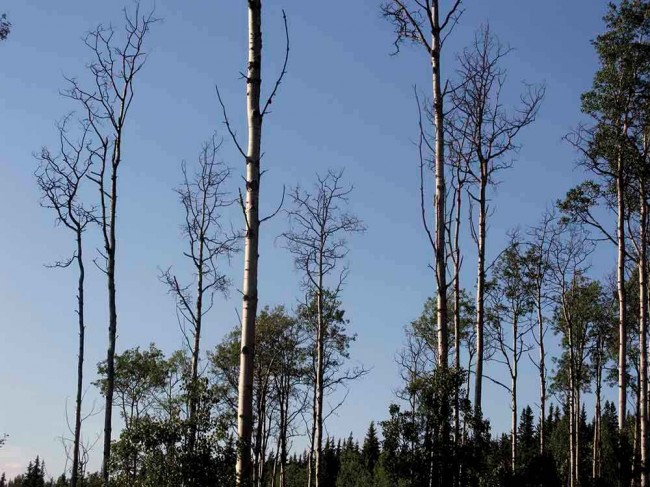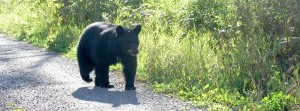
Photo Credit: Paul Glover
Are We Losing Our Aspens?
It’s a beautiful day in May 2012 and the air is filled with millions of tiny, fluttering moths. In spite of their numbers they are easy to overlook; they resemble bits of ash or dust drifting on the breeze. But as small as they are—with a wingspan of just a few millimetres—these moths may be bringing major ecological changes to our forests.
A few weeks later, when aspen trees have fully leafed out, it is plain to see that their leaves have a silvery hue rather than their usual rich green. Closer examination shows a whitish, maze-like trail on the leaves. It appears that nearly every leaf on every tree is affected. This is the work of the aspen serpentine leafminer—the larvae of the moths that emerged en masse that May.
A dawning awareness
Until 2012, the leafminer could be found in aspen forests in small numbers, with occasional outbreaks of higher populations. But the infestation of the past few years is a true epidemic and has not gone unnoticed. Many people have commented on the difference in the trees’ summer appearance and in autumn, when we expect brilliant yellows and oranges across our valley landscapes, the leaves turn directly to brown and fall to the ground without any decorative fanfare.
People wondered if leafminers could actually damage the aspens. “Naah!” I’d reply. “Aspens are indestructible!” But just last year I started to notice some changes in the aspen woods around our house. Many young saplings and sprouts at the edges of mature tree clusters were dead and individual mature trees here and there were dying with no apparent reason. The density of leaves in the remaining trees seemed to be thinning, too.
Elsewhere in the Bulkley Valley and across the Northwest I see the same thing. This year it looks a little worse.
Could the leafminers be responsible for this? Well, let’s see: All the trees in a cluster, or “clone,” of aspens grow from one big root mass, which sends nutrients and water up into the trees. The leaves, on the other hand, photosynthesize sunlight and send this energy back down to feed the roots. If the leafminers affect the leaves’ ability to photosynthesize, the root mass will suffer and in turn will have less ability to support the trees. Although these large root systems have tremendous reserves, they cannot keep putting out nutrients without sufficient energetic input from above.
What the experts say
Ken White, regional entomologist for the Ministry of Forests, Lands and Natural Resource Operations (FLNRO), is concerned. “Aspens are not too happy in general,” he says. “Several years of severe leafminer infestation has taken a toll.”
Besides growth reductions, early leaf-fall and loss of autumn colour, the all-out assault from leafminers stresses and weakens trees, making them vulnerable to other health problems—of which there can be many: “Aspen leaves are rich in nutrients and are sought by numerous species of insects. Tent caterpillars may be the next big threat and when they defoliate a tree there will be very little photosynthesis taking place.”
Besides this possibility there already exists a plethora of troublesome aspen pests, with more potentially arriving as northern winters become less severe. While cutting an aspen in my yard this spring I discovered large galleries (tunnels and chambers) bored in the heart of the tree. After examining the wood, White says he believes this is the work of the poplar borer, an insect that has not previously been found this far north. The larvae—up to five cm in length—live in the tree’s trunk for up to five years before maturing and can chew through a lot of wood in that time.
Alex Woods, regional pathologist with FLNRO, has also been paying attention to what’s happening to the aspens in our area.
“I’ve already observed considerable mortality in mature aspen trees in the Bulkley Valley,” he says. “Even if the leafminer infestation dies back, a lot of damage has already been done, leaving aspens more susceptible to diseases and insects.”
Tree diseases are Woods’ specialty and he is troubled that the weakened state of our aspens may leave them open for large-scale attacks from diseases like Venturia leaf blight. This fungal disease has been found in BC at low levels since 1966, but there are signs that it could be on the increase. Numerous other diseases are known to attack aspens and may come out in force when conditions are right.
“It’s kind of spooky when a species we think of as indestructible turns out to be vulnerable,” he says.
The bigger picture
In 2002 there were reports of entire aspen stands dying in southwestern Colorado. Surveys in 2006 showed some 12,000 hectares were dead, but by 2009, just three years later, this had jumped alarmingly to 220,000 hectares—almost 20 times as much. Nearly 15 percent of the state’s aspen forest had just plain died.
Researchers have called this phenomenon Sudden Aspen Decline, or SAD, and it is occurring throughout the western US. The reasons for the drastic increase in aspen mortality are not fully understood, but most agree that the main culprit is lack of water. Much of the western US has now been experiencing dry or drought conditions for 15 years, accompanied by warmer temperatures.
Although evidence indicates that droughts have come and gone over millennia, climatologists suggest that future droughts are likely to be more severe than in the past, thanks to accelerated climate change and the effects of deforestation and urbanization. Some even think we could be in the early stages of a “megadrought” that could last 100 years and transform our western forests into desert scrubland.
While BC has not been as droughty as the western states, we are currently in our third consecutive very dry year. Longer, more severe droughts are forecast for here as well.
Climate connection
Is there a connection between our warmer, drier conditions and the success of aspen pests? It looks pretty likely. Our warmer winters could be allowing higher populations of leafminer moths, which have to survive the winter tucked into crevices on aspen trunks and in duff on the forest floor. Increased overnight temperatures in August may help the spread and virulence of the Venturia blight disease. Drought stress makes the trees more vulnerable to all the various organisms that prey on their leaves, bark, trunk and roots.
“Variability of weather is tough on these trees,” Woods says.
Could we lose our aspens or a significant portion of them? Both Woods and White are concerned we could. We have two recent precedents: In the past 20 years we have lost half the province’s lodgepole pines to a single species of beetle and many of our two species of large willow trees in northwest BC have been killed by a weevil. While the main threat from mountain pine beetle has passed, young pines in some areas are now beset by a fungal disease that is exacerbated by warmer summers and winters. The recovery of willows is still in its early stages and their future is unknown.
It is difficult to imagine our valleys without aspens. The changes would be huge. Their ecological importance is high; some call them a “keystone species,” linked to all other ecosystems we depend on. They moderate spring snowmelt and help retain soil moisture and groundwater. Their filtered light creates micro-ecosystems that nurture many plants and animals. Many songbirds are dependent on aspens for habitat and food. And, of course, they are an important part of our visual landscape.
Is it really the leafminer that’s causing problems for our aspens? Yes and no. There appears to be such a complex web of interwoven elements that it’s impossible to isolate a single factor—except that we are living in a warming world, a fact that seems to lurk behind all the other effects.







